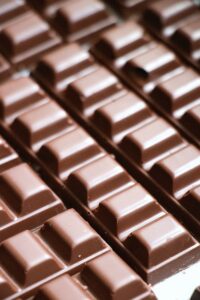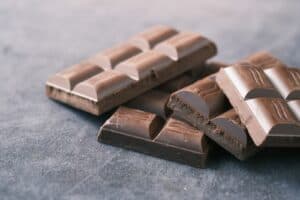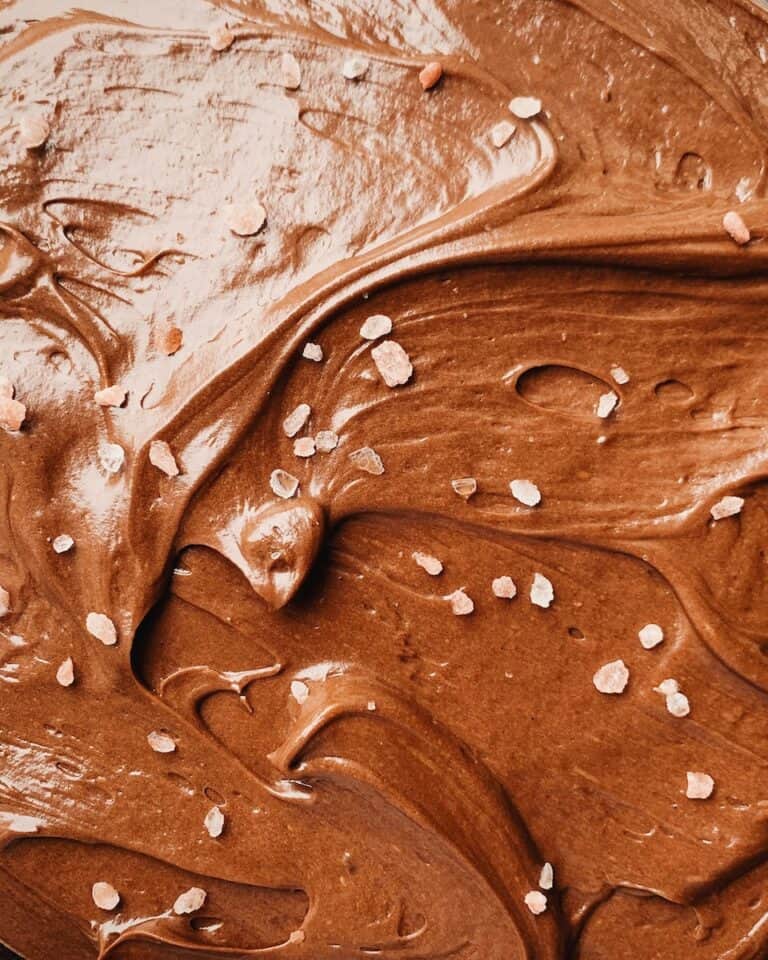What is blonde chocolate? Blonde chocolate, a relatively recent addition to the world of confections, has piqued the interest of many dessert enthusiasts and pastry chefs alike. But what exactly is it, and how does it differ from its more well-known counterparts – milk chocolate, dark chocolate, and white chocolate? Simply put, blonde chocolate is a delicious and golden variation of white chocolate with a distinct caramelized chocolate flavor profile.
Created accidentally by pastry chef Frédéric Bau when he left white chocolate in a bain marie for too long, blonde chocolate is the result of the Maillard reaction – the same reaction responsible for the delightful flavors in perfectly browned food. The key to making blonde chocolate is gently heating high-quality white chocolate, which is rich in cocoa butter and milk powder, to caramelize its sugar content. This process brings out toasted notes, smooth butterscotch, and toffee flavors that both enhance and perfectly complement the inherent sweetness of the base chocolate.
To make your own blonde chocolate, gather high-quality white chocolate, sugar, milk, and a pinch of salt. Melt the white chocolate in a food processor or bain marie until smooth, then stir in the other ingredients. Carefully bake the mixture on a baking tray lined with parchment paper in a single layer in the oven for a few hours, keeping a close eye to ensure a caramel hue without burning. Once cooled, break the chocolate into smaller pieces, and voila – you’ve crafted a uniquely delicious blonde chocolate treat that’s bound to impress.

Discovering Blonde Chocolate
Blonde chocolate is a delicious, relatively recent addition to the world of chocolate varieties. It can often be mistaken for just white chocolate due to its color, but its unique taste sets it apart. To better understand this confection, let’s explore the differences between blonde, white, milk, and dark chocolate.
White, milk, and dark chocolate are distinguished by their varying proportions of cocoa butter, sugar, and milk powder. Milk chocolate, for instance, has more milk powder than dark chocolate. In contrast, white chocolate contains no cocoa solids, relying solely on cocoa butter for its signature creaminess. So, what makes blonde chocolate stand out from the rest?
Pastry chef Frédéric Bau is credited with the creation of blonde chocolate while experimenting with melted chocolate. He accidentally left white chocolate in a bain marie for an extended period, resulting in a caramelized, smooth, and golden delicacy. Its taste profile is often described as a combination of butterscotch, toffee, and caramel flavors, with a hint of salt and toasted notes.
Making blonde chocolate involves heat, time, and patience. The process starts by slowly cooking high-quality white chocolate, allowing the sugar to caramelize and the milk crumb, formed by milk and sugar, to undergo the Maillard reaction. This reaction between amino acids and sugar in the presence of heat creates distinct toasted and brown flavors.
If you’re keen on trying your hand at a blonde chocolate recipe, here are the basic steps:
1. Preheat your oven to a low heat, around 250°F (120°C).
2. Break up high-quality white chocolate into small pieces and spread them in a single layer on a baking tray covered with parchment paper.
3. Bake the chocolate for a few hours, stirring and redistributing it every 10 minutes to ensure even caramelization and to prevent burning.
4. Once the chocolate reaches a deep golden color, carefully remove it from the oven and let it cool. It will become smooth and glossy once it cools down.
5. Use your homemade blonde chocolate in various recipes or as a delicious snack on its own.
Some pastry chefs and chocolatiers also like to blend their blonde chocolate with other ingredients like nuts, fruits, or spices to create unique blonde chocolate bars. In case you’re wondering, the nutritional profile of blonde chocolate is generally similar to that of white chocolate, with the total amount of sugar and fat being the main factors affecting how much a nutrient contributes to a daily diet.
In a world filled with milk, dark, white, and ruby chocolate, blonde chocolate has carved out its niche as a delightful caramelized chocolate known for its delicious flavor and beautiful golden hue. Its distinctive toasted notes and sweetness are sure to make it a favorite among chocolate lovers.
Flavor Profile and Culinary Uses

Blonde chocolate is a delightful confection that often leaves people intrigued about its unique flavor profile. Though it might look like just white chocolate, there’s actually much more to it. Pastry chefs describe its taste as a perfect blend of butterscotch, caramel, and smooth toffee flavors, making it a delicious addition to various recipes.
Caramelized chocolate, more commonly recognized as blonde chocolate, emerged as a relatively recent addition to the world of confections. It was introduced by pastry chef Frédéric Bau when he accidentally left a batch of high-quality white chocolate in the oven for a few hours. The chocolate underwent a Maillard reaction, in which heat induces amino acids and sugar to create new flavors, resulting in a golden, toasted appearance and taste with distinct caramel and toffee notes. The serendipitous discovery has since gained global attention.
Blonde chocolate can be made from scratch using a blonde chocolate recipe with just three main ingredients – cocoa butter, milk powder, and sugar. Here’s a simple process to follow:
1. Preheat the oven to a low temperature setting.
2. In a food processor, mix together cocoa butter and milk powder until it forms a smooth, melted chocolate consistency.
3. Add sugar and salt to the mixture for desired sweetness and stir gently.
4. Pour the mixture onto a baking tray lined with parchment paper, spreading it in a single layer.
5. Place the tray in the oven and watch as the chocolate caramelizes. It’s crucial to stir the mixture at regular intervals to ensure even cooking.
6. When the chocolate reaches a golden hue, remove the tray from the oven and set it aside to cool.
7. For a silky-smooth end product, transfer the cooled chocolate to a bain marie or heat-proof bowl over a pan of barely simmering water, stirring until smooth.
8. Pour the caramelized chocolate into molds to create blonde chocolate bars or use it in your preferred recipes.
When it comes to culinary uses, pastry chefs and home bakers alike have found diverse ways to incorporate blonde chocolate into their recipes. From milk crumbs to cake decorations, blond chocolate bars, and even ruby chocolate blends, the possibilities are truly endless.
For those keeping track of their dietary intake, the general nutrition advice is to bear in mind that blonde chocolate, like milk and dark chocolate, contributes to the daily diet and nutrient values. So, while it’s perfectly fine to enjoy this golden, sweet delight, it’s important to consume it in moderation.
In conclusion, blonde chocolate is a unique treat that goes well beyond being just white chocolate. With its rich flavor profile of caramel, butterscotch, and toffee notes, it’s a welcome addition to the traditional chocolate spectrum and, undoubtedly, many more irresistible recipes.
Final Thoughts
So, what have we discovered about blonde chocolate? It’s a unique and delicious type of chocolate, different from the more well-known milk, dark, and white chocolate varieties. Blonde chocolate results from the careful caramelization of high quality white chocolate, coaxing out toasty, butterscotch flavors while maintaining a smooth and creamy texture. Pastry chefs around the world, including the renowned Frédéric Bau, have embraced this scrumptious confection, incorporating it into a variety of recipes, from blonde chocolate bars to milk crumbs.
Making blonde chocolate at home is possible with a few key ingredients – high quality white chocolate, sugar, milk powder, salt, and a watchful eye. By carefully heating the mixture in a bain marie, stirring constantly, and then baking it in a single layer on a parchment paper-lined baking tray, you too can create your own blonde chocolate. Remember to let it cool for a few hours, and then break it into pieces to enjoy or integrate into your favorite recipes.
Let’s not forget about the nutritional aspect of blonde chocolate – it does contain cocoa butter, sugar, and milk powder, so it’s crucial to keep portion size in check and remember that moderation is key. Chocolate in general can be a source of various nutrients, amino acids, and, of course, a delicious treat – just make sure to stay within the guidelines for general nutrition advice when indulging.
Finally, it’s interesting to note that blonde chocolate is a relatively recent addition to the world of chocolate confections, having been accidentally discovered when a pastry chef left white chocolate in the oven for too long. As of now, another variety called ruby chocolate has joined the ranks of milk, dark, white, and blonde chocolate, expanding our options for delightful sweets even further. As our taste buds explore these new flavors, it’s clear that chocolate continues to surprise and delight us with its vast range of nuances.
So, what are you waiting for? Grab a quality white chocolate bar and try your hand at making your own delicious and sweet blonde chocolate treat!
